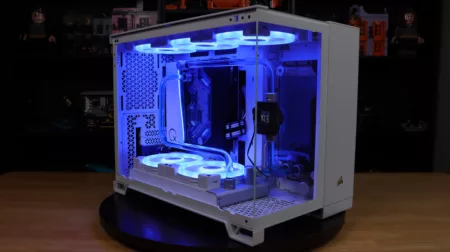We’re back with another Z77 motherboard, this time around we have Gigabyte’s mid-range offering for the Z77 platform: the GA-Z77X-UD5H motherboard. Featuring Gigabyte’s signature feature set along with choice components, this motherboard boasts many bells and whistles that should satisfy many people. For this review, we have the Wi-Fi and Bluetooth bundle of this motherboard designated as the GA-Z77X-UD5H-WB, and in a very congested Z77 market, it’ll need every ounce of feature to stand out. Let’s check out what Gigabyte’s bringing and let’s make this showy!
Gigabyte is part of what has come to be known as the “Big 3” motherboard makers in the world and serves an integral part in the progression of technology in the motherboard market. Gigabyte also boasts an extensive product line featuring graphics cards, chassis, notebooks and peripherals as well as very memorable endeavors in the cooling market. As a company, their motherboard division is their core business and today we’ll be looking at one such product. As most will know, Intel earlier this year released the Ivy Bridge 3rd generation Core i-series processors along with its accompanying 7 series chipset. Without AMD in the picture, Intel is enjoying itself but motherboard makers are constantly duking it out to make themselves shine and sway possible consumers and as we all know, the motherboard segment is all about three things: feature, performance and price. Let’s check the specs and images on our review item for today, the Gigabyte GA-Z77X-UD5H-WB then move on to performance testing.
This list is quite long. If you want a clearer view and more information on Gigabyte features, see the product page here.
| CPU |
(Some Intel® Coreâ„¢ processors require a graphic card, please refer “CPU support List” for more information.) |
| Chipset |
|
| Memory |
(Please refer “Memory Support List” for more information.) |
| Onboard Graphics | Integrated Graphics Processor:
|
| Audio |
|
| LAN |
|
| Expansion Slots |
|
| Multi-Graphics Technology |
|
| Storage Interface | Chipset:
2 x Marvell 88SE9172 chips:
|
| USB | Chipset:
Chipset + 2 VIA VL810 Hubs:
|
| IEEE 1394 | VIA VT6308 chip:
|
| Internal I/O Connectors |
|
| Back Panel Connectors |
|
| I/O Controller |
|
| H/W Monitoring |
|
| BIOS |
|
| Unique Features |
|
| Bundle Software |
|
| Operating System |
|
| Form Factor |
|
| Remark |
|
Gigabyte has adopted a new styling for their motherboards recently and have ditched the previous UD3, UD5, and UD7 color distinctions and have went with a simple black and blue color scheme for the UD line. Checking out the board at this view, it isn’t really something that stands out. There’s a certain lack of visual appeal coming off from the board especially for a mid-range variant. One thing worth noticing though is Gigabyte’s matte black PCB. This is even more evident when viewing the back of the motherboard. Matte black has a certain appeal that will certainly be up to one’s taste and in my personal opinion, it’s a good one. The board’s simple styling coupled with the matte black finish gives the board a very clean look.
We start our tour of the motherboard layout with the rear I/O expansion ports. The Gigabyte’s GA-Z77X-UD5H features rich display connectivity with VGA, DVI, HDMI and DisplayPort output. For expansion, we have 2 USB2.0 and 4 USB3.0 ports in the back. Along with these are an e-SATA connector and a IEEE 1394 port. We’re starting to see that this board is rich in connectivity and we get more hint of that with two Ethernet ports in the back. Finally, we get 8-channel audio options.
Moving on to the internal headers, we get more assortment of available connectors. From the right, we immediately get treated with two more USB3.0 front panel connectors. Next up is a SATA3 port, the Dual BIOS switch, front panel header, an extra fan header, two internal USB2.0 headers, a TPM header, front panel IEEE 1394 header and finally some front panel audio connectors. Boy, that’s a lot of options.
Aside from the one we already saw, the main SATA ports are plenty also. We have 8 available from here, 6 from the Intel chipset of which two are SATA3 capable and the remaining ones are SATA2 (colored in black). The grey SATA ports are powered off the Marvell controller and are SATA3 capable. There is a note included that says that SATA port 5 will be disabled when the mSATA slot is used.
Further upward we see the 24pin power supply connector and the DIMM slots. The slots are paired in alternating slots from the right. We can see there’s another USB3.0 header in this area giving us a total of 8 USB3.0 ports when fully utilized. Some enthusiast goodies can be spotted in this section starting with the outer edge where we can see voltage check points. Next to those are the Port 80 debug LED and tack switches for power, reset and clearing the CMOS.
Again, we’d like to stress Gigabyte’s choice of heatsinks. They’re small, and even though brightly colored, don’t really seem that appealing to me. Anyways though, these heatsinks cool a powerful 12-phase VRM which should be plenty of juice for your processors.
In the middle of the board we can spot a large clearing and a retention module. This is for mSATA and mini-PCIe cards.
BIOS images provided by Tech Porn
Gigabyte’s UEFI implementation is called 3D BIOS. This is due to the fact that their “simple mode” is in 3D… of sorts. We prefer the advanced mode though, it’s got all the toys we need to fiddle around with this baby. Going back to the advanced layout, Gigabyte presents us with a clean layout with sections most will be familiar with. The overclocking options are rich and provide granular control of our motherboard and processor. Rich voltage options are also available which makes Gigabyte’s BIOS a nifty overclocking playground.
Note: Our sample came with no colored retail box.
Inside the package we have some documentations, a couple of installation discs for the WiFi/Bluetooth add-on card, the add-on card itself, and a pair of antennas. Also included is front panel USB3.0 hub, some SATA cables and the backplate.
TEST SETUP
| Processor | Intel Ivy Bridge Core i7 3770K 3.5Ghz (Turbo up to 3.9Ghz) |
| Motherboards | Gigabyte GA-Z77X-UD5H-WB, ECS Z77H2-A2X Golden Board |
| Cooling | Corsair H80 (Maximum Fan Speed) |
| Power Supply | Silverstone Strider Plus ST65F-P 650W |
| Memory | Kingston HyperX T1 DDR3-2400 @XMP-2133 (unless stated otherwise) |
| Video Cards | ASUS HD7870 DirectCUII |
| Hard Drive | Kingston HyperX SSD 120GB |
| Operating System | Windows 7 64-bit SP1 |
We’ll be including Sandy Bridge-E results in our computational graphs for comparative purposes only. For direct comparison, the Z77H2-A2X from ECS will serve as the main comparative motherboard featuring a similar connectivity package as the Gigabyte GA-Z77X-UD5H-WB.
Setting up the board is the same as with any other motherboard, no special methods to perform aside maybe from connecting the provided PCI-e add-on card that gives the board it’s Wi-Fi and Bluetooth connectivity. Connect the two provided antennas to the connector in the back and you’re good to go. All our tests have been performed on a fresh install of Windows 7.
Just a note though, we’ve revamped our graphs and benchmarking suite along with our graphs. We will be including more and more results in future reviews.
PERFORMANCE
SiSoft’s SANDRA is a benchmarking, testing and system information application which provides plenty of options in gaining information regarding your system. For this test, we gauge the raw computational power of the CPU with the Processor Arithmetic benchmark based on the Whetstone and Dhrystone test. Both tests run completely within the processor so it gives a good picture of how a processor performs.
The results show us there’s no significant difference between the Z77 boards we tested. The difference is small compared to the lead that the SB-E processor holds. On stock, the Gigabyte board leads but overclocked, we see it stumble just a bit against the other Z77 board.
wPrime is a multi-threaded benchmarking application designed to measure the raw computational power of a CPU. It can be configured to run on a custom number of threads to accomodate multi-core CPUs.
In this test, the Gigabyte board takes a nice lead against the ECS board but once again stumbles in the overclocking tests but still managed to hold itself enough to not let the competition take the win.
Maxon offers a nice benchmark tool called Cinebench which really stresses your entire system to render a very complex scene. The output score is completely unique to Cinebench but allows us to have a rough idea of how the CPU works with 3D rendering tasks.
Gigabyte pushes again on top taking both stock and OC scores for the win in our Cinebench CPU benchmark runs.
SuperPI is another benchmarking tool that utilizes the pure computational power of a CPU. This test however is purely single-threaded and shows us the performance of a single core which gives us a good picture of how a processor performs on similar tasks.
We see very nice overclocked scores in this benchmark with the Gigabyte board leading all throughout. On stock though, it fights by a hairline against the other board.
3D Mark06 is a benchmarking software designed to measure the performance of a system in DirectX9 applications. The test has long been updated with newer version of the software for more modern use but the CPU test is still relevant and still gives us a good image of system performance by loading the CPU with logic, path-finding and physics computation tasks.
The GA-Z77X-UD5H shows very good stock performance but that lead doesn’t scale along when we overclock our processor.
3DMark Vantage is the successor to 3DMark 06 and is targeted for DirectX10 compliant devices. Similar to our 3DMark 06 test, we only take the CPU scores using the Performance preset.
Unlike 3DMark 06, our Gigabyte board benefits highly when overclocked on this test and demonstrates very nice stock performance also putting up scores that even the overclocked ECS board can’t compete with.
WORKLOAD TESTS
We use a 150MB 1080p MP4 video and convert it to standard iOS format using Xilisoft Video Converter. GPU acceleration is disabled and conversion is purely done by the CPU.
Nice results from the Gigabyte motherboard, shedding off over 20 seconds when overclocked.
We use WinRAR 4.0 on default settings to compress 3340 files of varying types including MP3s, various images and documents for a total of 2.40GB of data.
On stock alone, the UD5H easily thrashes the A2X and this goes on in the OC run where it takes the Gigabyte board just a bit over 3 minutes to finish compressing our files.
We resize 3,030 varying images of different formats and sizes to our standard 1200×900 resolution and note the time it takes to finish up the batch job.
The GA-Z77X-UD5H takes the win easily on this test, completely leaving the other board in the dust. Note the improvement we get after overclocking compared to the ECS board where the effect is somewhat disappointing.
X264 HD is a free benchmarking tool that shows the performance of a system by converting a 720p video clip.
Similar to test above, we see that nice overclock performance scaling from the Gigabyte board show itself here again.
GAME TESTS
Ungine’s Heaven benchmark is a DirectX application designed to measure the performance of a system in game-like loads.
Gigabyte takes a backseat in OC performance for this one as it gets smoked by the ECS board here. Stock though is different as we see the Gigabyte board lead by almost 20 points.
Contrary to our other Futuremark benchmarks, we run the full Performance benchmarks suite of this application.
The benchmark modes in Civilization5 are designed to stress and test various aspects of the users hardware and supporting software. This benchmark is designed to simulate a late game workload as it exercises all aspects of the game engine pipeline since all simulation and renderable object types are represented at a frequency consistent with a game that has been in progress for 300+ turns. We capture the full render score for our comparison graphs.
On stock, Civ V dampens the board quite a bit but the GA-Z77X-UD5H manages to get back to its feet when overclocked.
Battlefield 3 is the latest intallment in the highly-acclaimed FPS franchise from EA. Battlefield 3 puts players in modern combat situations with highly detailed environment and in-game graphics, whose Ultra detail settings, can bring most systems to their knees. Graph results are for average FPS.
Overall, the Gigabyte board manages to provide a smooth gaming experience but no benefit is had when overclocked.
OVERCLOCKING
Our 3770K sample is an average overclocker and has yet to show us any record-breaking figures but still, it can do respectable overclocks with ease.
Gigabyte shows off its overclocking potential more with a nice lead in this overclock test.
Gigabyte nearly gets an all-kill in our OC test but ECS manages to one-up the GA-Z77X-UD5H in one of our memory tests. Still, the Gigabyte takes the final win as ECS’s golden board fails to properly work with DDR3-2400 speeds and refuses to boot at all.
TEMPERATURE and POWER CONSUMPTION
We check to see how the motherboard maker tunes their default BIOS settings and see how it impacts temperatures and power consumption. The system is left to idle for 30 minutes before readings are taken and load data is taken 30 minutes while Prime95 blend test is running. Power readings are taken for the entire system from the socket.
Gigabyte’s board consumes 3watts more than the ECS one but is basically around the same power consumption level.
Again, we see very similar results from both boards.
One thing worth mentioning though is that Gigabyte’s motherboard, particular during BIOS setup, consumes around 110w due to the fact that the processor runs at full frequency. We hope to see Gigabyte address this as most other boards we’ve seen uses far less power during idle. Another concern we have is it’s standby and shutdown power draw is around 5.6 to 6.3W which are also quite high for USB charging only. Other than those, the board stays within our expected power draw all throughout testing.
CONCLUSION
From a purely performance standpoint, Gigabyte’s GA-Z77X-UD5H-WB performs very nicely and it’s overclocking performance is also impressive. It might not hold the performance crown in some of our benchmarks but it doesn’t trail by a large margin as well.
The GA-Z77X-UD5H-WB will set you back around Php12,500 and the vanilla version without the WiFi/Bluetooth add-on card a bit less than that. At that price range, it goes directly against mid-range motherboards and is a direct competition to ECS Z77H2-AX which also features 3x PCI-E x16 slots and WiFi/BT connectivity.
Gigabyte’s main point on this motherboard is that it boasts an awesome array of connectivity options especially network, USB3.0 and SATA as its main selling point. But at this price range, we expect a bit more when it comes to the visual presentation of the motherboard.
If performance is the only consideration for choosing a motherboard, then this motherboard is surely on top of the pack in its price range but style is still definitely a consideration and Gigabyte misses the mark here. We surely do love the overclocking potential this motherboard has but in turn, a functional board like this would have a better place in a gaming and SOHO computer and would see few overclocked uses on those conditions.
In closing, we have a hard time recommending the GA-Z77X-UD5H. Just like a lot of motherboard in the market today, it suffers from a massive identity crisis by trying to do a lot of things at once. If you need multiple LAN connections as well as Wi-Fi and Bluetooth and need a ton of USB3.0 connections, you’ll find no other board like the GA-Z77X-UD5H. If you just want a performance, mid-range motherboard for your Ivy Bridge build, we only suggest this product if you prefer Gigabyte’s products.
HOT
- Rich connectivity options
- Lots of USB3.0 ports
- Lots of SATA ports
- Wireless and Bluetooth bundle
- Solid performance
- Very rich overclocking options
- Voltage checkpoints
- Onboard buttons
- 12-phase VRM
- BIOS protection
- Good choice of components
- Memory support
NOT
- Could be cheaper
- Hard to maximize internal connectivies
- Lacks gamer appeal






10 Comments
how bg of a msata drive can i put in it / ty
I’m not particularly sure but if you’re going to run it as a cache drive you’re limited to 64GB as Intel’s specification. If you’re running off a msata drive on it though as a plain drive, it’ll take in any capacities out there right now.Â
Hope that helps. 🙂
ty
You’re welcome. 🙂
which is better one ssd or a two ssd one for caceing ? Ty
I suggest just sticking to one for pure caching purposes. What kind of usage do you usually do on your computer?
video recoding. what do u mean only one? so just one with the os on it? f this s what u mean then is the msata slot better to use for my os ? ty
What kind of performance do you want to get our of your machine?
A cache drive will help you get read improvements but write speeds will still be the same so saving movies to the drive will still be the same speed but copying and reading off it will be faster.
If you want to go with a cache SSD, the mSATA is suggested for smaller capacities.Â
i take my dvd movies that i own and turn them nto hgh def vdeo files . want more speed on converting them . ty $ your help.
The thread’s starting to get smaller so I’m replying here. 🙂
Can you share what computer specs you have like the processor, RAM size and graphics card? It may be possible that something else might be bottle-necking your encoding as most hard drives can handle encoding tasks easily.